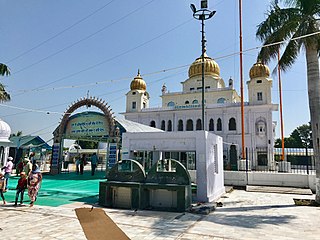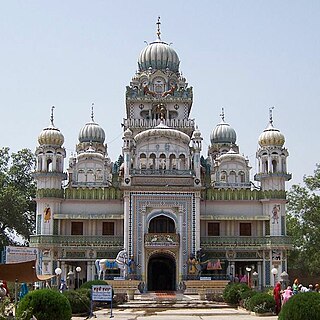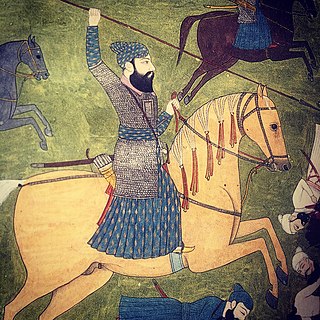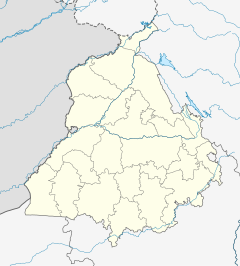
Guru Gobind Singh was the tenth and last human Sikh Guru. He was a warrior, poet, and philosopher. In 1675, at the age of nine he was formally installed as the leader of the Sikhs after his father Guru Tegh Bahadur was executed by Emperor Aurangzeb. His four biological sons died during his lifetime – two in battle and two executed by the Mughal governor Wazir Khan.

Anandpur Sahib, also referred simply as Anandpur, is a city in Rupnagar district (Ropar), on the edge of Shivalik Hills, in the Indian state of Punjab. Located near the Sutlej River, the city is one of the most sacred places in Sikhism, being the place where the last two Sikh Gurus, Guru Tegh Bahadur and Guru Gobind Singh, lived. It is also the place where Guru Gobind Singh founded the Khalsa Panth in 1699. The city is home to Takhat Sri Kesgarh Sahib, Third of the five Takhts in Sikhism.

The Takht Sri Darbar Sahib Damdama Sahib, is one of the five takhts or Seat of Temporal Authority of Sikhism, located in Talwandi Sabo in Punjab, India. At this place Guru Gobind Singh, the tenth Sikh Guru, prepared the full version of the Sikh scriptures called Sri Guru Granth Sahib in 1705. The other four Takhts are the Akal Takht, Takht Sri Keshgarh Sahib, Takht Sri Patna Sahib and Takht Sri Hazur Sahib.

Mata Gujri, also spelt as Mata Gujari, was the wife of Guru Tegh Bahadur, the ninth Guru of Sikhism, and the mother of Guru Gobind Singh, the tenth Guru of Sikhism. She played a central role in the history of Sikhism and is one of the four consorts bestowed with the title of Guru-Mahal.

Fatehgarh Sahib is a city and a sacred pilgrimage site of Sikhism in the north west Indian state of Punjab. It is the headquarters of Fatehgarh Sahib district, located about 5 kilometres (3.1 mi) north of Sirhind. Fatehgarh Sahib is named after Fateh Singh, the 7-year-old son of Guru Gobind Singh, who was seized and buried alive, along with his 9-year-old brother Zoravar Singh, by the Mughals under the orders of governor Wazir Khan during the ongoing Mughal-Sikh wars of the early 18th century. The town experienced major historical events after the martyrdom of the sons in 1705, with frequent changes of control between the Sikhs and Mughals.

Fateh Singh, commonly referred to with honorifics as Baba Fateh Singh or Sahibzada Baba Fateh Singh, was the fourth and youngest son of Guru Gobind Singh.

Ajit Singh (Punjabi: ਅਜੀਤ ਸਿੰਘ, pronunciation: [äːd͡ʒiːt sɪ́ŋgᵊ]; 11 February 1687 –23 December 1704), also referred to with honorifics as Sahibzada Ajit Singh or Baba Ajit Singh, was the eldest son of Guru Gobind Singh and the son of Mata Sundari. His younger brothers were Jujhar Singh, Zorawar Singh and Fateh Singh, but they had been born to Mata Jito. He was killed in the Second Battle of Chamkaur along with his brother Jujhar Singh. His other two brothers, Zorawar Singh and Fateh Singh, nine and seven years old, respectively, were bricked alive at Fatehgarh Sahib on order of Wazir Khan, governor of Sirhind-Fategarh.
Sadhaura is a city, near Yamunanagar city with Municipal Committee in Yamunanagar district in the Indian state of Haryana. A city of Yamunanagar, it is of great historic significance. Sadhaura is very old town many historical temples/Dargah are there like Manokamna Temple, Laxmi narayan Temple, Roza Peer Dargah are some famous places in Sadhaura.

Sirhind-Fategarh is a town and a municipal council in the Fatehgarh Sahib district in the Indian state of Punjab.

Shaheedi Sabha is a three-day annual religious congregation (get-together) organised every year in December at Gurdwara Fatehgarh Sahib, in the Fatehgarh Sahib district of Punjab, India to pay homage to the martyrdom of Chhotte Sahibzade Baba Zorawar Singh and Baba Fateh Singh, the youngest sons of the 10th sikh guru Guru Gobind Singh.

Chhotte Sahibzade attained martyrdom on 26 December 1704 at a very young age of 9 & 5(or 6) only. This is known as Saka Sirhind or the Chhotte Sahibzada Saka. Every year on 24 to 26 December, Shaheedi Jor Mela also known as Shaheedi Jor Mel/Sabha is organised at Fatehgarh Sahib Punjab, India, to commemorate the supreme sacrifice at the place of their martyrdom.

Gurdwara Mehdiana Sahib, also called the 'School of Sikh History' is a Sikh gurdwara located in the village of Mehdiana, just outside Mallha, near Jagraon in Ludhiana district, India.
Sirhind is the older name of Fatehgarh Sahib, a city and Sikh pilgrimage site in Punjab, India. It is situated on the Delhi to Lahore Highway. It has a population of about 60,851 . It is now a district headquarters in the state of Punjab; the name of the district is Fatehgarh Sahib.

The Haveli Todar Mal popularly known as Jahaz Haveli or Jahaz Mahal is the 17th century residence (haveli) of Todar Mal, who became the diwan in the court of Nawab Wazir Khan, the Governor of Sirhind, under Mughal Empire. Today, it is remembered for the cremation of young martyred sons of Guru Gobind Singh and his mother.
Baba Moti Ram Mehra was a devoted disciple and servant of Guru Gobind Singh who, disregarding the risk to his own life, managed to enter the Thanda Burj in a very dramatic manner and serve milk to Mata Gujri, Baba Zorawar Singh and Baba Fateh Singh, the two younger Sahibzadas (sons) of Guru Gobind Singh for three nights, where they were kept under arrest by the Mughal Governor of Sirhind, Wazir Khan.

Banda Singh Bahadur, was a Sikh warrior and a commander of the Khalsa army. At age 15, he left home to become an ascetic, and was given the name Madho Das Bairagi. He established a monastery at Nānded, on the bank of the river Godāvarī. In 1707, Guru Gobind Singh accepted an invitation to meet Bahadur Shah I in southern India, he visited Banda Singh Bahadur in 1708. Banda became disciple of Guru Gobind Singh and was given a new name, Gurbaksh Singh(as written in Mahan Kosh), after the baptism ceremony. He is popularly known as Banda Singh Bahadur. He was given five arrows by the Guru as a blessing for the battles ahead. He came to Khanda, Sonipat and assembled a fighting force and led the struggle against the Mughal Empire.
Lohgarh is a historic town in Bilaspur tehsil of Yamunanagar district of Haryana in India. It was the capital of the Sikh state under Baba Banda Singh Bahadur from 1710 to 1716.
Naulakha is a major village in Fatehgarh Sahib District, in the Indian state of Punjab.

Fateh Singh was a warrior in Sikh history. He is known for beheading Wazir Khan who was the Mughal Governor of Sirhind, administering a territory of the Mughal Empire between the Sutlej and Yamuna rivers. Wazir Khan was infamous for ordering the execution of the two young sons of Guru Gobind Singh, Sahibzada Fateh Singh and Sahibzada Zorawar Singh in 1704.




























